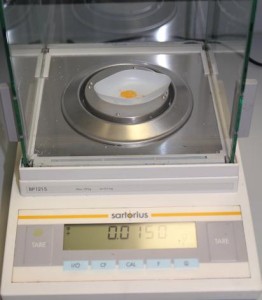
By Maria Kinti, 2nd year student, MPhil Textile Conservation.
Two years of studying Textile Conservation in Glasgow are about to finish with the final assignment, the dissertation, being in progress during this summer.
This is a 15,000- words project that we undertake during 12 weeks. The topics each year are research based and range from material science related subjects to investigations about conservation practice and theory (conservation ethics and materials culture). The dissertation offers the chance to focus on a specific topic, expand one’s research skills, learn and experiment with something new.
For my dissertation project I am investigating the use of fluorescent labelling and fluorescence light microscopy to study the penetration of adhesives for the consolidation of Tibetan Thangka paintings. My motivation behind choosing this topic is to promote the use of scientific application for improving conservation practice and the provision of methodological guidelines for conservators.
Fluorescent labelling (or tagging) is used in biomedical sciences as a method for detecting compounds or tissues by chemically binding them to fluorescent molecules. Fluorescent dyes are in a powdery form and need to be dissolved in a solvent before using them. The colour of the fluorescence can vary based on the chosen dye and it can only be seen with the use of specific filters that fluorescence microscopes have. This filter allows only particular wavelengths of a higher intensity light that come from a mercury lamp to pass through.

In conservation, fluorescent labelling can be used as a technique for labelling adhesives and then visualizing them, after their application on samples, through fluorescence microscopy. This process can help the researcher to examine the level of penetration, within the sample, and aid in the evaluation of the adhesive application method.
My project is divided into four major sections.
- Initially, a material investigation that will inform the construction of the Thangka swatches.
- Afterwards, an investigation into the dyes and the labelling techniques that will help in the selection of the fluorescent dye.
- Subsequently, an investigation into fluorescence light microscopy and its application together with fluorescent dyes, for studying the penetration of adhesives.
- Finally, an investigation into cross section techniques to identify if this methodology is suitable for preparing painting samples, impregnated with labeled adhesives, to be examined with fluorescence light microscopy.
The main aim of this project is to investigate the potential of using these techniques (fluorescent labelling and fluorescence light microscopy on cross-sections) in the textile conservation field and be able to provide guidelines and recommendations for future research in the field.
The research that I’ve done so far has guided me towards the use of a fluorescent dye that has the ability to form covalent bonds with both proteins and polysaccharides. This bondage makes them “shine” under the filtered light of the fluorescence microscope.
So far, I managed to replicate the traditional technique for the preparation of the paint surface. For preparing the samples, I’ve used cotton muslin that has been stretched in a wooden frame by using cotton strings. The cotton fabric was then sized with animal skin glue. The sizing followed the application of the preparation on both sides of the fabric. Based on the traditional technique, the preparation, widely known as gesso, was a mixture of white pigments such as chalk and Kaolin China clay and animal skin glue.
Moreover, I have managed to design the protocol for the fluorescent labelling of the adhesives, a process that I am about to start.
I’ll keep you informed about the second phase and the research outcomes of this very exciting project with a new blog post after submitting my dissertation.



